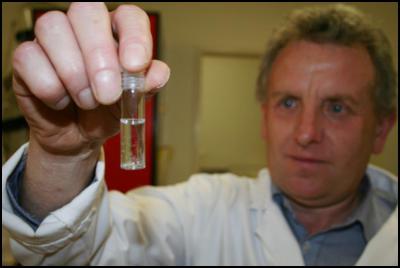Nematode name 50 years in the making
Nematode name 50 years in the making

Dr Mike
Wilson with the Nematodes
Advances in technology and international expertise have finally enabled the formal description and naming of a New Zealand nematode, more than 50 years after its original discovery.
The nematode, Alaninema ngata, was officially named and described in this month’s Nematology journal in the paper ‘Description and systematic affinity of Alaninema ngata n. sp. (Alaninematidae: Panagrolaimorpha) parasitising leaf-veined slugs (Athoracophoridae: Pulmonata) in New Zealand’.
Nematodes, commonly known as roundworms, live in most environments throughout the world. It’s been estimated that there may be up to one million different species, of which approximately 26,000 have been described.
First discovered by Dr Peter Johns of the University of Canterbury, the Alaninema ngata specimens were passed to his colleague, nematologist Professor Wallie Clark, in the early 1960s for description. A manuscript describing the nematode was originally written in in the 1980s and type specimens were deposited in a national collection.
AgResearch nematologist Dr Michael Wilson, who submitted the recent paper, says that although a manuscript describing the new species was written in the 1980s, it was never submitted.
Fresh work to publish the description in the early 2000s by former AgResearch scientist Gary Baker was scuppered when it was discovered the original samples had been lost.
“Since this discovery was made in the days before cheap DNA sequencing it would have presented a far greater challenge to understand how this species fitted within the nematode hierarchy,” Dr Wilson says.
“On my arrival in New Zealand in 2010, Gary Baker approached me as a new nematologist in NZ and asked if I could finish the job off.
“While delighted to get involved in anything to do with slug nematodes, I am not a taxonomist, so I passed Gary’s preserved specimens on to my friends and colleagues Elena Ivanova and Sergei Spiridonov at Russian Academy of Sciences in Moscow.
“While Elena prepared slides and drew the figures, I went out collecting with Gary Barker to find fresh specimens. Samples were given to AgResearch scientist Maria Tourna who extracted DNA and obtained a DNA sequence for analysis.
“The manuscript
was put together using Elena’s description and Gary’s
distribution and host range data, although much of the
introduction and discussion was largely based on Clark’s
original manuscript.”
New type material has been
deposited in at the Museum of New Zealand Te Papa Tongarewa
in Wellington.
“My final job was to track down Clark,
who is now in his eighties, to show him the new manuscript
and get him to agree to be an author,” says Dr
Wilson.
“This publication means the species has a
‘shelf life’ of more than 50 years from discovery to
formal description. While this sounds a long time, the mean
‘shelf life’ for describing new species is 21 years, so
it’s not too bad.”
ENDS


 Business Canterbury: Urges Council To Cut Costs, Not Ambition For City
Business Canterbury: Urges Council To Cut Costs, Not Ambition For City Wellington Airport: On Track For Net Zero Emissions By 2028
Wellington Airport: On Track For Net Zero Emissions By 2028 Landcare Research: ANZAC Gall Fly Release Promises Natural Solution To Weed Threat
Landcare Research: ANZAC Gall Fly Release Promises Natural Solution To Weed Threat NZ Anti-Vivisection Society: Auckland Rat Lovers Unite!
NZ Anti-Vivisection Society: Auckland Rat Lovers Unite! University of Canterbury: $1.35 Million Grant To Study Lion-like Jumping Spiders
University of Canterbury: $1.35 Million Grant To Study Lion-like Jumping Spiders Federated Farmers: Government Ends War On Farming
Federated Farmers: Government Ends War On Farming



